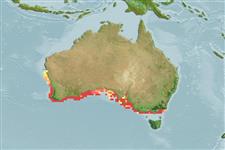Actinopterygii (peixes com raios nas barbatanas) >
Perciformes (Perch-likes) >
Arripidae (Australian salmon)
Etymology: Arripis: Latin, arripio, arripere = to take something suddenly.
Ambiente / Clima / Intervalo
Ecologia
; marinhas; estuarina; intervalo de profundidade 1 - ? m (Ref. 6390). Temperate, preferred 17°C (Ref. 107945); 26°S - 39°S, 112°E - 150°E
Eastern Indian Ocean: endemic to the southern coasts of Australia.
Tamanho / Peso / Idade
Maturity: Lm ? range ? - ? cm
Max length : 41.0 cm FL macho/indeterminado; (Ref. 27296); Peso máx. publicado: 800.00 g (Ref. 27296); Idade máx. registada: 7 anos (Ref. 27652)
Espinhos dorsais (total): 9; Raios dorsais (total): 16; Espinhos anais 3; Raios anais : 10; Vértebras: 25. Large eyes, diameter of which about one fifth of the head length. Body scales are slightly rough to touch. Body coloration: green above and silvery below with vertical rows of golden spots on the upper sides, tips of the caudal fin are black. Juveniles have dark golden bars on their sides (Ref. 6390). Length of upper lobe of caudal fin < 29.9% SL (Ref. 9701).
Usually found inshore in bays and estuaries over seagrass beds or near areas of seaweed (e.g. kelp), on rocky reefs, and along ocean beaches. Juveniles are found in inshore coastal waters, bays and inlets (Ref. 6390). Feed on small fish and prawns (Ref. 27946).
Both small, undeveloped ova (eggs) and larger ripe ova are present in the ovary at the same time. This phenomenon suggests that these species are either partial spawners (i.e. only some of the ova are spawned each time) or that the small ova remain in the ovary after spawning and are resorbed (Ref. 27945).
Kailola, P.J., M.J. Williams, P.C. Stewart, R.E. Reichelt, A. McNee and C. Grieve, 1993. Australian fisheries resources. Bureau of Resource Sciences, Canberra, Australia. 422 p. (Ref. 6390)
Status na Lista Vermelha da IUCN (Ref. 115185)
CITES (Ref. 94142)
Not Evaluated
Perigo para os humanos
Harmless
Uso pelos humanos
Pescarias: espécies comerciais; peixe esportivo: sim
Mais informação
ReferênciasAquaculturaPerfil para aquaculturaEstirpesGenéticaFrequência alélicaHereditariedadeDoençasProcessamentoMass conversion
ColaboradoresFotosStamps, CoinsSonsCiguateraVelocidadeTipo de nataçãoÁrea branquialOtólitosCérebrosVisão
Ferramentas
Relatórios especiais
Baixar XML
Fontes da internet
